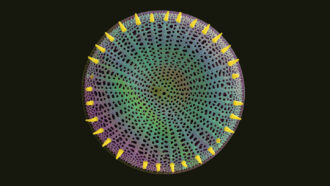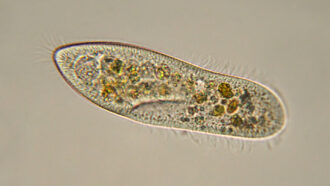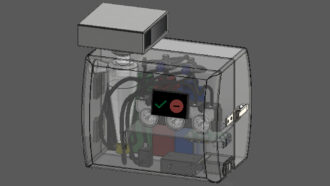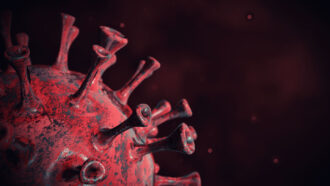A surface crater in viruses may be key to keeping colds from spreading
Compounds that stick in the pit can stop the virus from reproducing

A chemical compound (illustrated at center) binds to a never-before-seen pit on the surface (blue, white and magenta) of a type of disease-causing virus. The interaction stops this enterovirus from reproducing.
James Geraets
A newfound furrow on the surface of some viruses may be key to their ability to trigger disease. That could make this furrow a prime target for drugs to treat colds and other illnesses.
Sarah Butcher and Johan Neyts led a team of scientists in a search for new antiviral drugs. Both are virologists (Vy-RAHL-uh-jizts), scientists who study viruses. At the University of Helsinki in Finland, Butcher focuses on the structure of viruses. Neyts works at the University of Leuven in Belgium. He is searching ways to treat viral infections.
The scientists tested how well various compounds fight viruses in cells being grown in the lab. One chemical in particular caught their attention. It prevented one kind of virus — an enterovirus — from making copies of itself. This prevented the virus from spreading from cell to cell.
The researchers next used a technique called cryo-electron microscopy, or cryo-EM. It flash freezes molecules in a very cold liquid. That allows a very fine-scale view of the molecules’ structures.
Using cryo-EM, the scientists took a close-up look at how the virus and potential drug interacted. It showed that the compound seems to jam a previously unknown pit, or pocket, in the virus’s shell.
The researchers described the pocket June 11 in PLOS Biology.
This may work in other viruses, too
The germ they had been working with belongs to a virus family called picornaviruses. So the team decided to look at other members of that family. Some are rhinoviruses, which cause the common cold. Some are other enteroviruses, ones that can cause more dangerous infections, including hand, foot and mouth disease. Many of the related viruses, they now report, seem to have a similar pocket.
No drugs yet exist to treat rhinoviruses or enteroviruses. But the new finding offers hope for making such drugs, says Susan Hafenstein. She studies viral structures at the Pennsylvania State University College of Medicine in Hershey. She did not work on the new study. But she calls the pocket “an excellent target” for making drugs that might work against many such viruses.
One challenge is that these viruses mutate — change — easily and often. That ability makes it “easier for them to escape a drug,” she says. The best bet? Target some process that the virus needs to use to survive, she says. That way, if a virus mutates to avoid the drug, it could die as a result.
A virus infects cells by injecting its genetic material inside them. That genetic material then takes over the host cell’s machinery and makes more viruses. In picornaviruses, a shell surrounds the virus’s inner core of genetic material. That shell, previous research suggests, changes shape as these viruses prepare to inject their genetic material into a new host cell.
That shell is also where Butcher and Neyts’ team found the new pocket. Their compound of interest nestles into the pocket and sticks. Once there, it seems to lock itself in place. That stops the shell from changing its shape and releasing its genetic material. “This locking prevents the virus from infecting cells,” explains Butcher.
The researchers tested several similar compounds, too. Some were able to block many picornaviruses. That suggests that the pocket is a key feature in this virus family, Butcher says. That means it likely that it plays an important role in the virus’s life cycle.
The team is now working to make those compounds even more effective against the viruses, Neyts says. That’s an early step toward turning them into drugs to treat disease.







